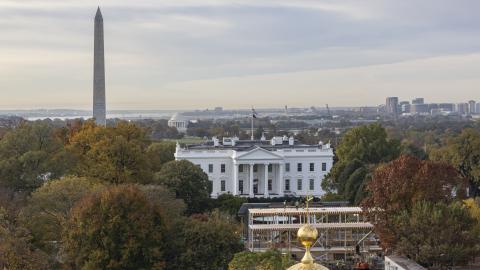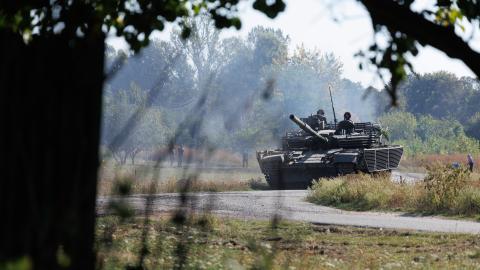If you're concerned that the world's leading state sponsor of terrorism has been expanding its strategic footprint in the Western Hemisphere, the Obama administration has a reassuring message for you: "Iranian influence in Latin America and the Caribbean is waning." That's the conclusion of a State Department report issued late last month. (The report itself is classified, but Foggy Bottom released an unclassified summary of its policy recommendations, from which the above quote is taken.)
The timing of this report was rather awkward. A few weeks earlier, Argentine special prosecutor Alberto Nisman had unveiled a massive, 500-page dossier exploring Iran's hemispheric terror links and its broader strategy for exporting violent revolution. (An English-language summary can be found here.) Nisman's findings suggest that the State Department might want to reconsider its assumptions about Iranian influence in the Americas.
Start with Argentina. Nisman has spent years investigating the 1994 Iranian-backed bombing that killed 85 people and injured hundreds more at the AMIA Jewish community center in Buenos Aires. In 2006, he formally accused Tehran of plotting the attack and using its terrorist proxy Hezbollah to carry it out. Interpol subsequently issued "red notices" (basically the equivalent of global arrest warrants) for several Iranian officials, including Ahmad Vahidi, the former Iranian Revolutionary Guard Corps (IRGC) commander who has been serving as Iran's defense minister since 2009.
Nisman's new report explains that Tehran began laying the groundwork for the 1994 massacre back in the 1980s, when it dispatched Iranian cleric Mohsen Rabbani to Argentina. Rabbani formally served as Iran's cultural attaché in Buenos Aires. Behind the scenes, however, he was building the intelligence structure that would eventually allow Iranian agents to execute the AMIA bombing (and also the 1992 bombing of Israel's Buenos Aires embassy). Indeed, Nisman fingers Rabbani as the mastermind of the attack. (He was one of the Iranians for whom Interpol issued red notices in 2007.)
The attack occurred at a moment when "Latin America was being strongly and aggressively infiltrated by Iran." Not only had the Iranians created a sophisticated intelligence apparatus in Argentina, they had also penetrated Guyana, the small South American country that borders Venezuela, Brazil, and Suriname. Their chief agent in Guyana was a Guyanese man named Abdul Kadir, who in the 1990s served as mayor of the country's second-biggest city and who later became a member of the Guyanese parliament. Six years ago, Kadir was arrested for conspiring to bomb New York City's JFK International Airport. According to Nisman, the bomb plot was an Iranian-devised schemeand before he was arrested, Kadir "had repeated contacts with Mohsen Rabbani." A confidential informant has testified that Kadir and his terrorist allies "wanted to form an organization like Hezbollah in the Caribbean." (In 2010, Kadir was sentenced to life in prison for his role in the airport bomb plot.)
Both Kadir and Rabbani tried to spread Iran's revolution across the hemisphere. Thanks to their efforts and the work of other Iranian spies, says Nisman, the Islamic Republic has established "clandestine intelligence stations and operative agents" throughout Latin America. He finds evidence that, in addition to Argentina and Guyana, Iranian agents have been active in countries as diverse as Brazil, Chile, Colombia, Paraguay, Suriname, Trinidad & Tobago, and Uruguay. They have been particularly active in the lawless Tri-Border Area, which comprises the intersection of Argentina, Brazil, and Paraguay.
In recent years, Iran has embraced several anti-American governments in Latin America, including the populist, autocratic regimes in Venezuela, Bolivia, and Ecuador. (There has also been a rapprochement between Tehran and Buenos Aires, which explains why Argentine president Cristina Kirchner refused to let Nisman testify at a U.S. congressional hearing last week.) The Islamic Republic has used these relationships to expand its hemispheric footprint, get around international sanctions, and bolster its nuclear program. To cite just a few examples from the past four years:
-
In 2009, the Associated Press reported (based on an Israeli foreign-ministry document) that Iran was receiving uranium from Venezuela and Bolivia. Several months later, former New York City district attorney Robert Morgenthau gave an important speech at the Brookings Institution detailing the various ways in which Venezuela was helping Iran evade global sanctions.
-
In 2010, a Pentagon report stated that the elite Iranian Quds Force (the "extraterritorial" branch of the IRGC) was increasing its presence in Latin America, and especially in Venezuela.
-
In 2011, U.S. authorities linked the Quds Force to a shocking assassination scheme, in which Iranian officials were attempting to use a Mexican drug cartel to bomb a Georgetown restaurant and kill the Saudi ambassador. Meanwhile, the German daily Die Welt reported that Iran was building rocket launch bases on Venezuela's Paraguaná Peninsula (which juts out into the Caribbean); a retired Peruvian general named Francisco Contreras told the Jerusalem Post that Iranian-sponsored terrorist groups were expanding their operations in South America; and a Univision documentary reported that Venezuelan and Iranian officials had been conspiring to launch cyberattacks against the United States.
-
In 2012, the Washington Post reported that Iran (1) had "dramatically expanded its diplomatic missions throughout the hemisphere" and (2) was filling its Latin American missions with Quds Force members. A few weeks later, Director of National Intelligence James Clapper said the 2011 Georgetown assassination plot demonstrated that "some Iranian officialsprobably including Supreme Leader Ali Khameneihave changed their calculus and are now more willing to conduct an attack in the United States in response to real or perceived U.S. actions that threaten the regime." Gen. Douglas Fraser, the head of U.S. Southern Command, subsequently told reporters that Iran was trying to build unmanned aerial vehicles for the Venezuelan military.
-
Earlier this year, analysts Douglas Farah and Pamela Philips Lum published a study that documented how Iran is attempting "to use a little-known Ecuadorean bank in state receivership, known as COFIEC, to open correspondent accounts with sanctioned Iranian banking institutions through a state-owned Russian bank."
-
More recently, in an interview with CNN, Farah stressed that overall Iranian influence in Latin America is actually growing: "They are more involved in the cocaine trade than ever before, and have greater access in the region due their allies in Venezuela, Ecuador, Bolivia and elsewhere," he said. "So they have more freedom of movement and fewer restrictions. This has greatly increased their capacity to carry out intelligence operations, train and position operatives, and prepare attacks, particularly if Israel or the U.S. strikes Iran's nuclear facilities" (my emphasis).
-
Just last week, journalist Sebastian Rotella of ProPublica reported that, in January 2012, a senior IRGC official traveled to Venezuela and met with high-ranking members of the Chávez regime: "At the secret meeting, Venezuelan spymasters agreed to provide systematic help to Iran with intelligence infrastructure such as arms, identification documents, bank accounts, and pipelines for moving operatives and equipment between Iran and Latin America, according to Western intelligence officials."
In short: There is abundant evidence that Iranian activity in Latin America is a greater threat to U.S. interests today than it was just a few years ago. Indeed, as Iran moves closer to the nuclear finish line, we should be more concerned than ever about its burgeoning presence in the Western Hemisphere.









